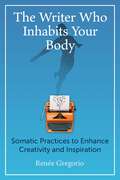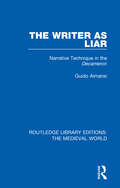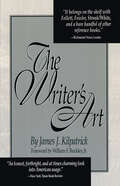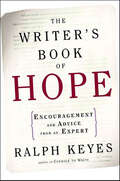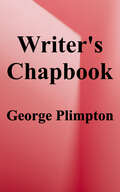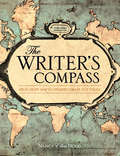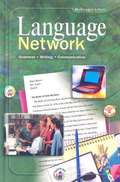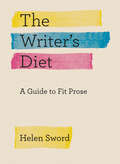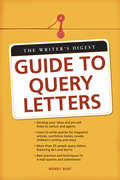- Table View
- List View
The Write to Read: Response Journals That Increase Comprehension
by Lesley J. RoessingUse reader response strategies to help students build understanding of complex literary and informational text, and provide supporting evidence in their writing—all goals of the Common Core.
The Writer Laid Bare: Emotional honesty in a writer's art, craft and life
by Lee KofmanThe Writer Laid Bare is a book for everyone who loves the craft of good writing. Be they a voracious reader wanting to know more or an emerging writer themselves, best-selling author and writing coach Lee Kofman has distilled her wisdom, insight and passion into this guide to writing and emotional honesty. A combination of raw memoir and a professional writing toolkit, Lee examines her own life, rich in story and emotion to reveal how committing to a truthful writing practice helped her conquer writer&’s block and develop her own authentic voice. &‘Show don&’t tell&’ has never been so compelling. Inspired by her popular writing courses, Lee also offers practical advice on drafts, edits and how to achieve a life/writing balance. How combining her writing with motherhood led her to recognise that &‘ the pram in the hall&’ issue is real. Plus the ultimate reading list of books you really should read, from Chekhov to Elena Ferrante and Helen Garner. &‘The Writer Laid Bare takes us on an intimate journey into the magical, and often challenging, terrain an author inhabits. Kofman courageously shares with the reader her own probing writerly journey of self-discovery.&’ - Leah Kaminsky
The Writer Who Inhabits Your Body: Somatic Practices to Enhance Creativity and Inspiration
by Renée Gregorio• Provides a comprehensive, step-by-step program for writers to use their bodies to expand their creative capacity on the page and in their lives • Offers hands-on exercises, rooted in the disciplines of Aikido and somatics, to help writers center themselves and better access their authentic inner voice • Helps writers confront obstacles like fear, doubt, and difficult emotions, transforming such subject matter into opportunities for creative exploration Writing is one of our most fundamental means of spiritual expression, a powerful capacity that enables us to shape and share our deepest thoughts, feelings, and experiences. Yet the writing process can be challenging and imprecise, and both novice and experienced writers may struggle with accessing their innermost creative selves. Taking an embodied approach to writing, poet and Aikido practitioner Renée Gregorio offers a step-by-step experiential program to help you to center yourself in your body and, in so doing, expand your creative capacity on the page and in your life. Rather than provide a guide to writing, she helps you identify and give voice to the writer within. She shares hands-on exercises rooted in the martial art of Aikido and the practice of somatics—or body-centered learning—to provide direct and detailed ways to help facilitate personal growth and tap in to innate creative capacities, enabling you to fully immerse yourself in the creative process and discover immediate benefits. Drawing on her extensive martial arts training, the author emphasizes creating your own internal writing &“dojo&” to clear the mind and enable you to access the deeper currents of language. Exploring discomfort as a doorway to deeper experience and new writing territory, she reveals how to examine difficult topics, express the full range of emotions, and turn self-doubt, fear, and painful experience into courage. She also explores how to unearth the power and physicality in your own voice, using techniques like &“re-visioning&” to effectively edit your work, ultimately embodying your writing with complexity and fullness. Through immersive and physically focused experience, this book will help seasoned and aspiring writers alike work with the body as a wise teacher to better access, hone, and express their authentic inner voice.
The Writer and the World: Essays
by V. S. NaipaulFor forty years V. S. Naipaul has been traveling and, through his writing, creating one of the most wide-ranging and sustained meditations on our world. Now, for the first time, his finest shorter pieces of reflection and reportage -- nearly all of them heretofore out of print -- are collected in one volume. With an abiding faith in the redemptive power of modernity balanced by a sense of wonder about the past, Naipaul has explored an astonishing variety of societies and peoples through the many-sided prism of his own experience. Whether writing about the Muslim invasions of India, Mobutu’s mad reign in Zaire, or the New York mayoral elections, he has demonstrated again and again that no one has a shrewder intuition of the ways in which power works, of the universal relation of the exploiter and the exploited. And no one has put forth a more consistently eloquent defense of the dignity of the individual and the value of civilization. Infused with a deeply felt humanism,The Writer and the Worldattests powerfully not only to Naipaul’s status as the great English prose stylist of our time but also to his keen, often prophetic, understanding.
The Writer as Liar: Narrative Technique in the Decameron (Routledge Library Editions: The Medieval World #2)
by Guido AlmansiOriginally published in 1975, The Writer as Liar examines the literary game of falsehood as it is portrayed in the Decameron. The book examines how Boccaccio’s collection of tales has a ‘frame’ story, its own built-in key to the art of story-telling, its internal logic of truth and falsehood, as well as its moments of self-parody, pure narrative intrigue and sophisticated sexual symbolism. The book formulates the argument that Boccaccio’s story telling is seen as an artfully malicious operation, depending for its success not on some abstract concept of narrative originality or the accurate depiction of human psychology, but on the combinative assemblage of narrative blocks, which are manipulated by a craftsman who must lie and cheat with raw material in order to produce a living work – therefore depicting the artist as a liar.
The Writer as Migrant
by Ha JinHa Jin's journey from an uneducated soldier in the People's Liberation Army in China to a resident of the United States raises questions about language, migration, and the place of literature in a globalizing world.
The Writer in the Garden
by Jane GarmeyShow me a person without any prejudice of any kind on any subject and I'll show you someone who may be admirably virtuous but is surely no gardener.--Allen Lacy. Idiosyncratic, determined, and occasionally obsessed, gardeners have a lot to say about their outdoor passion. THE WRITER IN THE GARDEN brings together a host of writing gardeners and gardening writers reveling in their quirks, confessing their shortcomings, and sharing their experiences. Combing through a hundred years of garden writing, editor Jane Garmey has discovered some great contemporary works and rediscovered many classics: "I am strongly of the opinion," declares Gertrude Jekyll, "that the possession of a quantity of plants, however good the plants may be themselves and however ample their number, does not make a garden." "It isn't that I don't like sweet disorder, but it has to be judiciously arranged," writes Vita Sackville-West. "Gardeners are--let's face it--control freaks," Abby Adams admits. "Who else would willingly spend his leisure hours wrestling weeds out of the ground, blithely making life or death decisions about living beings, moving earth from here to there, changing the course of waterways?" Drawing on the work of more than fifty writers, THE WRITER IN THE GARDEN covers subjects ranging from the beauty of the garden to ornery weeds, the hazards of rare plant collecting, and the tribulations of inclement weather. The collection includes a range of authors from both sides of the Atlantic: from Edith Wharton, who insists that we could all learn a thing or two about design from the Italians, to Stephen Lacey, who reveals that his most exciting gardening moments are spent in the bath. Some of the other writers in the collection are: E. B. White, Beverly Nichols, Ken Druse, Eleanor Perenyi, W. S. Merwin, Mirabel Osler, Henry Mitchell, Jamaica Kincaid, Robert Dash, Sara B. Stein, Michael Pollan, M.F.K. Fisher, Anne Raver, Patti Hagan, Paula Deitz.
The Writer's ABC Checklist
by Lorraine MaceAn easy-to-use comprehensive guide for writers on preparing and presenting their work to agents, publishers and print media. Regardless of the writer's level or ability, there is something extremely daunting about putting together a submission. It doesn't matter if it is for an article for a magazine, or short story for a competition, a humorous anecdote, a play or TV script, a novel or non-fiction book, The Writer's ABC Checklist will provide answers to questions you didn't even know you should ask. With its A-Z format, references can be found quickly and effortlessly. Unfamiliar terms are explained and bullet points at the end of most sections provide a quick reminder of the main items covered. This unique book is packed with writing tips and is something no aspiring writer can afford to be without. Lorraine Mace is a columnist with Writing Magazine, a writing judge, a tutor for the Writers Bureau and winner of an international poetry award. Maureen Vincent-Northam gained first place in a national children's book competition. An online tutor in genealogical writing, she is also a writing-competition judge.
The Writer's Art
by James J. Kilpatrick“A witty, entertaining, and enlightening antidote to sloppy, inflated, vague, or dull prose.” —Publishers WeeklyWriting comes in grades of quality in the fashion of beer and baseball games—good, better, and best. With the experience of a lifetime spent writing, James J. Kilpatrick wants to make a few judgment calls. Here, in the great tradition of Theodore Bernstein, Edwin Newman, and William Safire, a master of the art gives us a finely crafted, witty guide to writing well. Intended for laymen and professionals alike, The Writer’s Art highlights techniques and examples of good writing—and a section of the book called “My Crotchets and Your Crotchets” comprises more than two hundred personal judgment calls, often controversial, often funny, on word usage.“Put it on your shelf between Strunk & White’s Elements of Style and William Zinsser’s On Writing Well.” —Cleveland Plain Dealer“An honest, forthright, and at times charming look into American usage.” —The New York Times Book Review“The Writer’s Art is itself a work of art.” —Dallas Morning News
The Writer's Book of Hope: Encouragement and Advice from an Expert
by Ralph KeyesIn 1889, the editor of the San Francisco Examiner, having accepted an article from Rudyard Kipling, informed the author that he should not bother to submit any more. "This isn't a kindergarten for amateur writers," the editor wrote. "I'm sorry, Mr. Kipling, but you just don't know how to use the English language." A century later, John Grisham was turned down by sixteen agents before he found representation-and it was only after Hollywood showed an interest in The Firm that publishers began to take him seriously. The anxiety of rejection is an inevitable part of any writer's development. In this book, Ralph Keyes turns his attention from the difficulty of putting pen to paper-the subject of his acclaimed The Courage to Write -to the frustration of getting the product to the public. Inspiration isn't nearly as important to the successful writer, he argues, as tenacity, and he offers concrete ways to manage the struggle to publish. Drawing on his long experience as a writer and teacher of writing, Keyes provides new insight into the mind-set of publishers, the value of an agent, and the importance of encouragement and hope to the act of authorial creation.
The Writer's Book of Memory: An Interdisciplinary Study for Writing Teachers
by Janine RiderMemory has long been ignored by rhetoricians because the written word has made memorization virtually obsolete. Recently however, as part of a revival of interest in classical rhetoric, scholars have begun to realize that memory offers vast possibilities for today's writers. Synthesizing research from rhetoric, psychology, philosophy, and literary and composition studies, this volume brings together many historical and contemporary theories of memory. Yet its focus is clear: memory is a generator of knowledge and a creative force which deserves attention at the beginning of and throughout the writing process. This volume emphasizes the importance of recognizing memory's powers in an age in which mass media influence us all and electronic communication changes the way we think and write. It also addresses the importance of the individual memory and voice in an age which promotes conformity. Written in a strong, lively personal manner, the book covers a great deal of scholarly material. It is never overbearing, and the extensive bibliography offers rich vistas for further study.
The Writer's Chapbook: A Compendium of Fact, Opinion, Wit, and Advice, from the 20th Century's Preeminent Writers
by George PlimptonMaster compiler George Plimpton has created a fascinating and delightful survey of writers on writing in this collection of excerpts primarily from The Paris Review interviews.
The Writer's Compass: From Story Map to Finished Draft in 7 Stages
by Nancy Ellen DoddMap out your idea and finish your story in 7 stages! This book will show writers how to develop their ideas into a finished novel by working through it in 7 stages, while learning how to mapping out their story's progress and structure so they can evaluate and improve their work. It teaches writers to visualize their story's progress with a story map that helps them see all the different components of their story, where these components are going, and, perhaps most importantly, what's missing. The book simplifies Aristotle's elements of good writing (a. k. a. that each story should have a beginning, a middle and an end) into easily applicable concepts that will help writers improve their craft. The author helps readers strengthen their work by teaching them how to focus on one aspect of their story at a time, including forming stories and developing ideas, building strong structures, creating vibrant characters, and structuring scenes and transitions. Thought-provoking questions help writers more objectively assess their story's strengths and weaknesses so they may write the story they want to tell.
The Writer's Craft (Gold Level)
by Sheridan Blau Rebekah Caplan Peter Elbow Don KillgallonCompilation of writing excerpts and exercises that will teach you to be a better writer and reader.
The Writer's Craft (Gold Level)
by Mcdougal LittellIn each of the Writer's Workshops, you will experiment with ideas and approaches as you are guided through a complete piece of writing. Cross-references to the Handbooks will allow you to find additional help when you need it. Then, as you write, you will discover what you think about yourself--and about the world around you.
The Writer's Craft (Red Level)
by Mcdougal LittellThis book helps one discover the excitement in writing and become a great writer.
The Writer's Craft Green Level Grade 8
by Mcdougal LittellEducational book for grade 8 students. Contains writer's workshops with guided and related assignments, a writing handbook with mini-lessons in writing process, style, and academic skills; and a grammar and usage handbook with mini-lessons in grammar, usage, and mechanics.
The Writer's Craft: Idea to Expression
by Sheridan Blau Peter ElbowThis book recognizes that individuality, on every page you will be encouraged to discover techniques best suited to your own personal writing style. You will learn to think your way through every writing task, you will experiment with ideas and approaches as you are guided through a complete piece of writing. Cross-references to the Handbooks will allow you to find additional help when you need it. Then, as you write, you will discover what you think about yourself and about the world around you.
The Writer's Craft: Level 9
by McDougal LittellThis book recognizes the individuality. On every page the reader will be encouraged to discover techniques best suited to him/her own personal writing style. Just as important, the reader will learn to think his/her way through every writing task. In each of the Writer’s Workshops, the reader will experiment with ideas and approaches as he/she is guided through a complete piece of writing. Cross-references to the Handbooks will allow the reader to find additional help when need it. Then, as he/she writes, will discover what he/she thinks about himself/herself--and about the world around him/her.
The Writer's Devotional: 365 Inspirational Exercises, Ideas, Tips & Motivations on Writing
by Amy PetersWhether youre writing fiction or nonfiction, screenplays or poetry, or simply trying to keep a more compelling journal or blog, this invaluable volume, filled with 365 inspiring quotations and informative tutorials, will get your creative juices flowing. Each day of the week focuses on a different aspect of the writing life, from the business of writing, to the nuts and bolts of editing, to tips and tricks for getting past writers block.
The Writer's Diet: A Guide to Fit Prose (Chicago Guides to Writing, Editing, and Publishing)
by Helen SwordDo your sentences sag? Could your paragraphs use a pick-me-up? If so, The Writer's Diet is for you! It's a short, sharp introduction to great writing that will help you energize your prose and boost your verbal fitness. Helen Sword dispenses with excessive explanations and overwrought analysis. Instead, she offers an easy-to-follow set of writing principles: use active verbs whenever possible; favor concrete language over vague abstractions; avoid long strings of prepositional phrases; employ adjectives and adverbs only when they contribute something new to the meaning of a sentence; and reduce your dependence on four pernicious "waste words": it, this, that, and there. Sword then shows the rules in action through examples from William Shakespeare, Emily Dickinson, Martin Luther King Jr. , John McPhee, A. S. Byatt, Richard Dawkins, Alison Gopnik, and many more. A writing fitness test encourages you to assess your own writing and get immediate advice on addressing problem areas. While The Writer's Diet is as sleek and concise as the writing ideals contained within, this slim volume packs a powerful punch. With Sword's coaching writers of all levels can strengthen and tone their sentences with the stroke of a pen or the click of a mouse. As with any fitness routine, adhering to the rules requires energy and vigilance. The results, however, will speak for themselves.
The Writer's Digest Character Naming Sourcebook
by Sherrilyn KenyonThis reference for writers provides meanings for some 25,000 names and surnames from 45 countries, listed by origin. An explanation of naming practices and historical context is provided for each origin section, and there is a reverse lookup of names by meaning, as well as an alphabetical index of names. An introduction gives practical advice on naming characters and places plus tips on naming for specific genres, and sidebars within the entry sections tell how published authors solved their naming dilemmas. Kenyon (whose name means Blond from the White Meadow) is a fantasy author. Annotation ©2006 Book News, Inc., Portland, OR (booknews.com)
The Writer's Digest: Guide to Query Letters
by Wendy Burt-ThomasMake That Crucial, Positive First Impression Anyone who's researched the marketplace knows: The path to publication begins with your query letter. If your query is weak, unfocused, or uninspired, an editor or agent won't even bother to request your article, novel manuscript, or nonfiction book proposal. But a well-crafted, compelling query sent to the right editor or agent is an essential sales tool for fiction writers and the most effective way for nonfiction writers to pre-sell your idea. In this book, professional freelance writer and magazine editor Wendy Burt-Thomas shares practical advice on how to craft persuasive letters that connect with editors and agents and ultimately generate sales for you. You'll learn how to: Conduct targeted research to find suitable editors and agents Hook an editor with a tantalizing lead and shape a summary that compels editors to buy Select the strongest slant for your book or article Use research and interview shortcuts that keep your query prep profitable Make your query rejection-proof by weeding out subtle mistakes that can sabotage your project Communicate your author platform and sell yourself as the best writer for the subject Complete with dozens of sample queries–some that landed article assignments, agents, or book deals, and others that never stood a chance–this book offers you a comprehensive strategy for presenting your writing ideas in a way that will increase your chances of publication. Though the title may lead some to believe it's strictly to be shelved as a reference manual,The Writer's Digest Guide to Query Lettersis a smooth read from cover to cover.
The Writer's Essential Tackle Box
by Lynn PriceThe Writer's Essential Tackle Box offers an insider's view that informs and educates writers to key occupations that comprise the publishing industry--how they work, why they work, and pitfalls to avoid. A must-read for the new author seeking guidance through every aspect of the murky waters of publishing.


